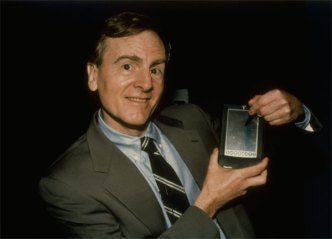Telecommunications Services for the 1990’s (British Post Office, 1969)
[youtube=http://www.youtube.com/watch?v=qqtoVmACDng?w=480]
Year(s) depicted: the 1990s
Futuristic items shown: wideband coaxial cables linking homes with the telecommunications system; videoconferencing; smartcards for identifying yourself to the network; video document-scanning service; electrostatic document printing; cassette-based answering machine; pagers; online banking; computer-based home-buying advisor; telecommuting.
Amusing anachronisms: Black-and-white screens look more like computers from the late 1970s than from the 1990s; apparent lack of QWERTY input.
Backstory: In the 1960s, the British Post Office was also responsible for Great Britain’s phone system, which was later spun off into the company that became British Telecom. It proved that Americans didn’t have a monopoly on tech-utopia thinking by producing this movie. The Post Office Research Station at Dollis Hill, where it was made, had an impressive résumé: Colossus, the first programmable digital computer, had been built there in 1943.
The movie’s predictions about telecommunications in the 1990s are, on the whole, pretty smart — even if the production values and acting are marginal even by the threadbare standards of the category.
Knowledge Navigator (Apple, 1987)
[youtube=http://www.youtube.com/watch?v=1Mk4iQ5ghNQ?w=480]
Year depicted: 2011 or thereabouts (there’s a reference to a 2006 document being about five years old)
Futuristic items shown: folding touch-screen computer with color display; human-like on-screen intelligent agent; flawless voice recognition and synthesis; memory cards; videoconferencing with document-sharing features; fancy what-if graphing engine.
Amusing anachronisms: The Knowledge Navigator’s boxy industrial design seems to have been supervised by the guy responsible for the Apple IIc; 21st-century Apple is shown still using the rainbow-apple logo which Steve Jobs axed in 1998.

Getty Images
Backstory: In 1987, Apple CEO John Sculley published Odyssey, an account, co-written with John Byrne, of his time at Pepsi and Apple. It featured a section on a concept Sculley called the Knowledge Navigator, a “wonderful fantasy machine” which provided instant access to a wealth of information. (Apple’s ambitious-but-unsuccessful 1993 Newton Personal Digital Assistant was an attempt to bring a very rough draft of certain parts of the idea to market.)
In this famous film, which debuted as part of Sculley’s keynote at a 1987 education conference, Apple imagined what its CEO’s brainchild might look and sound like. It was heady stuff — at the time, most PC users weren’t online in any fashion.
A quarter-century later, it’s difficult to understand why anyone inside or outside of Apple would have found the Knowledge Navigator’s bow-tied-butler assistant appealing. But multiple bits and pieces of the gadget depicted in the film have become reality in the form of iPhone and iPad features such as the iPhone 4S’s Siri assistant. Anyone care to hazard a guess as to whether they would have come to market if Sculley had stayed Apple’s CEO and Steve Jobs had remained in exile?
Project 2000 (Apple, 1988)
[youtube=http://www.youtube.com/watch?v=fEkX4ipKeas?w=480]
Year depicted: 2000
Futuristic items shown: pocket-sized clamshell computing device with multimedia show-and-tell and scientific visualization software; giant flat-screen classroom screen and smaller workplace flat screen; AirPlay-like video transmission; tablet computer used for adult literacy and education, with 3D animated dinosaurs, voice recognition, voice synthesis and OCR.
Amusing anachronisms: The movie seems to say that the people of 2000 may get their sports news by scanning dead-tree newspapers into tablet computers.
Backstory: Like Knowledge Navigator, this film dates from Apple’s Sculley era, when its dreams were far more exciting than its products. The company held a future-of-education contest called Project 2000, which was judged by such luminaries as Steve Wozniak and Ray Bradbury and won by a tablet device imagined by a team from the University of Illinois at Urbana-Champaign. In most respects that matter, this fantasy tablet is remarkably reminiscent of the iPad which Apple released two decades later.
The Project 2000 film, which intersperses comments from the competition judges with dramatizations, doesn’t show the prize-winning tablet. Instead, it features Sculley’s Knowledge Navigator and a pocket-sized doodad which doesn’t look all that much like anything which actually became popular. It also shows a grade schooler doing multimedia show-and-tell on a big display — a scenario that must have felt like sci-fi in 1988, but which eventually came to be in almost exactly the manner that the movie imagined.
1995 (Hewlett-Packard, 1989)
Year depicted: 1995
Futuristic items shown: flat-screen computer monitors; on-screen intelligent agents; slick drag-and-drop user interface; videoconferencing; giant boardroom flat-screen display for presentations; networked information systems; voice recognition; PC-based voicemail; PC-based video; laptops with color screens and built-in trackballs.
Amusing anachronisms: It’s pretty easy to avoid them when you’re looking out only six years into the future.
Backstory: At first blush, HP’s 17-minute film –the spellbinding tale of “BioChemix Incorporated” and its quest to win the “Layton account” — comes off as a low-rent version of Apple’s Knowledge Navigator. I suspect that it was meant in part to promote NewWave, an HP product of the era that bolted a slicker user interface on top of Windows.
The on-screen agents — including a robot and a woman in a 1980s big-shoulderpad suit — remind us that this is movie dates from the era of Microsoft Bob and Clippy. (I like how “Angie” seems to speak with the voice of an actress trying to sound like she’s a synthesized voice.)
During the real-world version of 1995, HP discontinued NewWave, thereby getting out of the business of building most of the items shown in the movie. But except for those pesky agents, 1995 does a decent job of predicting where business productivity would go in the 1990s.
Starfire (Sun Microsystems, 1992)
Year depicted: 2004
Futuristic items shown: “Sun Video Collaboration Booths” in airports; desks with built-in, touch-screen computing interfaces, fancy multimedia editing features, Silly Putty-like scanning and voice navigation; tablet computers; remote-controlled cameras; point-and-click 3D animation; hydrogen-powered, zero-emissions cars; virtual-reality videoconferencing.
Amusing anachronisms: Princess Diana is said to be a member of the House of Commons in 2004 (okay, that’s more sad than funny); Sun-branded notebooks apparently using extremely high-speed dial-up, complete with dial tones; mention of a “big one” earthquake in LA in 1999.

Nielsen Norman Group
Backstory: In 1992, Bruce “Tog” Tognazzini — an influential interface designer best known for the 14 years he spent at Apple — was working at Sun Microsystems. He spearheaded the creation of Starfire, which showed Sun products ushering in a new era of business productivity. He also chronicled the project in a book called Tog on Software Design.
Tog says that more than a hundred people collaborated on the movie; it certainly has a deluxe feel, with more fully fleshed-out visualizations of future hardware and software than other films of this ilk, such as HP’s 1995.
It’s a shame that Sun never got the chance to create Starfire‘s gizmos — including the ones that still haven’t arrived — in real life. By 2004, the company, which was instrumental in the rise of the Internet, was too busy fighting for its corporate life to change the world again in the manner that the movie prophesied. Six years later, it was gobbled up by Oracle.
[MORE TECH NOSTALGIA ON TIME.COM: The 50 Worst Cars of All Time)


